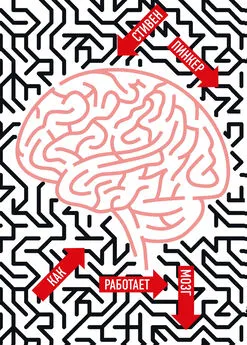Стивен Пинкер - Язык как инстинкт
- Название:Язык как инстинкт
- Автор:
- Жанр:
- Издательство:Эдиториал УРСС
- Год:2004
- Город:М.
- ISBN:5-354-00332-6
- Рейтинг:
- Избранное:Добавить в избранное
-
Отзывы:
-
Ваша оценка:
Стивен Пинкер - Язык как инстинкт краткое содержание
Предлагаемая вниманию читателя книга известного американского психолога и лингвиста Стивена Пинкера содержит увлекательный и многогранный рассказ о том феномене, которым является человеческий язык, рассматривая его с самых разных точек зрения: собственно лингвистической, биологической, исторической и т.д. «Существуют ли грамматические гены?», «Способны ли шимпанзе выучить язык жестов?», «Контролирует ли наш язык наши мысли?» — вот лишь некоторые из бесчисленных вопросов о языке, поднятые в данном исследовании.
Книга объясняет тайны удивительных явлений, связанных с языком, таких как «мозговитые» младенцы, грамматические гены, жестовый язык у специально обученных шимпанзе, «идиоты»-гении, разговаривающие неандертальцы, поиски праматери всех языков. Повествование ведется живым, легким языком и содержит множество занимательных примеров из современного разговорного английского, в том числе сленга и языка кино и песен.
Книга будет интересна филологам всех специальностей, психологам, этнографам, историкам, философам, студентам и аспирантам гуманитарных факультетов, а также всем, кто изучает язык и интересуется его проблемами.
Для полного понимания книги желательно знание основ грамматики английского языка. Впрочем, большинство фраз на английском языке снабжены русским переводом.
От автора fb2-документа Sclex’а касательно версии 1.1: 1) Книга хорошо вычитана и сформатирована. 2) К сожалению, одна страница текста отсутствовала в djvu-варианте книги, поэтому ее нет и в этом файле. 3) Для отображения некоторых символов данного текста (в частности, английской транскрипции) требуется юникод-шрифт, например Arial Unicode MS. 4) Картинки в книге имеют ширину до 460 пикселей.
Язык как инстинкт - читать онлайн бесплатно ознакомительный отрывок
Интервал:
Закладка:
Geertz C. 1984. Anti anti-relativism // American Anthropologist, 86. P. 263–278.
Geisel T. S. 1955. On beyond zebra, by Dr. Seuss. New York: Random House.
Gelman S. A. & Markman E. 1987. Young children’s inductions from natural kinds: The role of categories and appearances // Child Development, 58. P. 1532–1540.
Gentner D. & Jeziorski M. 1989. Historical shifts in the use of analogy in science // B. Gholson W. R. Shadish Jr., R. A. Beimeyer & A. Houts (Eds.), The psychology of science: Contributions to metascience. New York: Cambridge University Press.
Geschwind N. 1979. Specializations of the human brain // Specific American, September.
Geschwind N. & Galaburda A. 1987. Cerebral lateralization: Biological mechanisms, associations, and pathology. Cambridge, Mass.: MIT Press.
Gibbons A. 1992. Neanderthal language debate: Tongues wag anew // Science, 256. P. 33–34.
Gibbons A. 1993. Mitochondrial Eve refuses to die // Science, 259. P. 1249–1250.
Gibson E. 1998. Linguistic complexity: Locality of syntactic dependencies // Cognition 68. P. 1–76.
Gleitman L. R. 1981. Maturational determinants of language growth // Cognition, 10. P. 103–114.
Gleitman L. R. 1990. The structural sources of verb meaning // Language Acquisition, 1. P. 3–55.
Goldsman M. 1992. Quayle quotes. Various computer networks.
Goodglass H. 1973. Studies on the grammar of aphasics // H. Goodglass & S. E. Blumstein (Eds.), Psycholinguistics and aphasia. Baltimore: Johns Hopkins University Press.
Goodman N. 1972. Seven strictures on similarity // Problems and projects. Indianapolis: Bobbs-Merrill.
Gopnik M. 1990a. Dysphasia in an extended family // Nature. P. 344, 715.
Gopnik M. 1990b. Feature blindness: A case study // Language Acquisition. P. 139–164.
Gopnik M. 1993. The absence of obligatory tense in genetic language impairment. Unpublished manuscript, Department of Linguistics, McGill University.
Gopnik M. & Crago M. 1991. Familial aggregation of a developmental language disorder // Cognition, 39. P. 1–50.
Gordon P. 1986. Level-ordering in lexical development // Cognition, 21. P. 73–93.
Gould J. L. & Marler P. 1987. Learning by instinct // Scientific American, January.
Gould S. J. 1977. Why we should not name human races: A biological view // S. J. Gould. Ever since Darwin. New York: Norton.
Gould S. J. 1981. The mismeasure of man. New York: Norton.
Gould S. J. 1985. The flamingo’s smile: Reflections in natural history. New York: Norton.
Gould S. J. & Lewontin R. C. 1979. The spandrels of San Marco and the Panglossian program: A critique of the adaptationist programme // Proceedings of the Royal Society of London, 205. P. 281–288.
Green D. M. 1976. An introduction to hearing. Hillsdale, N. J.: Erlbaum.
Greenberg J. H. (Ed.) 1963. Universals of language. Cambridge, Mass.: MIT Press.
Greenberg J. H. 1987. Language in the Americas. Stanford, Calif.: Stanford University Press.
Greenberg J. H., Ferguson C. A. & Moravcsik E. A. (Eds.) 1978. Universals of human language (4 vols.). Stanford, Calif.: Stanford University Press.
Greenfield P. M. & Savage-Rumbaugh E. S. 1991. Imitation, grammatical development, and the invention of protogrammar by an ape // Krasnegor et al. 1991.
Grice H. P. 1975. Logic and conversation // P. Cole & J. L. Morgan (Eds.), Syntax and Semantics 3: Speech acts. New York: Academic Press.
Grimshaw J. 1990. Argument structure. Cambridge, Mass.: MIT Press.
Grosjean F. 1982. Life with two languages: An introduction to bilingualism. Cambridge, Mass.: Harvard University Press.
Guy J. 1992. Genes, peoples, and languages? An examination of a hypothesis by Cavalli-Sforza // LINGUIST electronic bulletin board, January 27.
Hakuta K. 1986. Mirror of language: The debate on bilingualism. New York: Basic Books.
Hale K., Krauss M., Watahomigie L, Yamamoto A., Craig C., Jeanne L. M., & England N. 1992. Endangered languages // Language, 68. P. 1–42.
Halle M. 1983. On distinctive features and their articulatory implementation // Natural Language and Linguistic Theory, 1. P. 91–105.
Halle M. 1990. Phonology // Osherson & Lasnik 1990.
Harding R. M. & Sokal R. R. 1988. Classification of the European language families by genetic distance // Proceedings of the National Academy of Science, 85. P. 9370–9372.
Hardy-Brown K., Plomin R. & DeFries J. C. 1981. Genetic and environmental influences on the rate of communicative development in the first year of life // Developmental Psychology, 17. P. 704–717.
Harman G. (Ed.) 1974. On Noam Chomsky: Critical essays. New York: Doubleday.
Harnad S. R., Steklis H. S. & Lancaster J. (Eds.) 1976. Origin and evolution of language and speech (special volume) // Annals of the New York Academy of Sciences, 280.
Harris R. A. 1993. The linguistics wars. New York: Oxford University Press.
Hart J., Berndt R. S. & Caramazza A. 1985. Category-specific naming deficit following cerebral infarction // Nature, 316. P. 439–440.
Haugeland J. (Ed.) 1981. Mind design. Cambridge, Mass.: MIT Press.
Hawkins J. (Ed.) 1988. Explaining language universals. Basil Blackwell.
Hayakawa S. I. 1964. Language in thought and action (2nd ed.). New York: Harcourt Brace.
Heath S. B. 1983. Ways with words: Language, life, and work in communities and classrooms. New York: Cambridge University Press.
Heider E. R. 1972. Universals in color naming and memory // Cognitive Psychology, 3. P. 337–354.
Hillis A. E. & Caramazza A. 1991. Category-specific naming and comprehension impairment: A double dissociation // Brain, 114. P. 2081–2094.
Hinton G. E. & Nowlan S. J. 1987. How learning can guide evolution. Complex Systems, 1. P. 495–502.
Hirschfeld L. A. & Gelman S. A. (Eds.) 1994. Domain specificity in cognition and culture. New York: Cambridge University Press.
Hirsh-Pasek K. & Golinkoff R. M. 1991. Language comprehension: A new look at some old themes // Krasnegor et al. 1991.
Hockett C. F. 1960. The origin of speech // Scientific American, 203. P. 88–111.
Hofstadter D. R. 1985. Metamagical themes. New York: Basic Books.
Holden C. 1987. The genetics of personality // Science, 237. P. 598–601.
Holm J. 1988. Pidgins and creoles (2 vols.). New York: Cambridge University Press.
Holmes R. B. & Smith B. S. 1977. Beginning Cherokee (2nd ed.). Norman, Okla.: University of Oklahoma Press.
Hubel D. 1988. Eye, brain, and vision. San Francisco: Freeman.
Humboldt W. von. 1836/1972. Linguistic variability and intellectual development (G. C. Buck & F. Raven, Trans.). Philadelphia: University of Pennsylvania Press.
Hurford J. R. 1989. Biological evolution of the Saussurean sign as a component of the language acquisition device // Lingua, 77. P. 187–222.
Hurford J. R. 1991. The evolution of the critical period in language acquisition // Cognition, 40. P. 159–201.
Huttenlocher P. R. 1990. Morphometric study of human cerebral cortex development // Neuropsychologia, 28. P. 517–527.
Ingram D. 1989. First language acquisition: Method, description, and explanation. New York: Cambridge University Press.
Jackendoff R. S. 1977. X-bar syntax: A study of phrase structure. Cambridge, Mass.: MIT Press.
Jackendoff R. S. 1987. Consciousness and the computational mind. Cambridge, Mass.: MIT Press.
Jackendoff R. S. 1992. Languages of the mind. Cambridge, Mass.: MIT Press.
James W. 1892/1920. Psychology: Briefer course. New York: Henry Holt & Company.
Jespersen O. 1938/1982. Growth and structure of the English language. Chicago: University of Chicago Press.
Jeyifous S. 1986. Atimodemo: Semantic conceptual development among the Yoruba. Doctoral dissertation, Cornell University.
Johnson S. 1755. Preface to the Dictionary. Перепечатано в: E. L. McAdam, Jr., and G. Milne (Eds.), 1964, Samuel Johnson’s Dictionary: A modern selection. New York: Pantheon.
Joos M. (Ed.) 1957. Readings in linguistics: The development of descriptive linguistics in America since 1925. Washington, D. C: American Council of Learned Societies.
Jordan M. I. & Rosenbaum D. 1989. Action // Posner 1989.
Joshi A. K. 1991. Natural language processing // Science, 253. P. 1242–1249.
Kaplan R. 1972. Augmented transition networks as psychological models of sentence comprehension // Artificial Intelligence, 3. P. 77–100.
Kaplan S. 1992. Environmental preference in a knowledge-seeking, knowledge-using organism // Barkow, Cosmides, & Tooby 1992.
Kasher A. (Ed.) 1991. The Chomskyan turn. Cambridge, Mass.: Blackwell.
Katzner K. 1977. The languages of the world. New York: Routledge & Kegan Paul.
Kay P. & Kempton W. 1984. What is the Sapir — Whorf hypothesis? // American Anthropologist, 86. P. 65–79.
Kaye J. 1989. Phonology: A cognitive view. Hillsdale, N. J.: Erlbaum.
Keenan E. O. 1976. Towards a universal definition of «subject» // C. Li (Ed.), Subject and Topic. New York: Academic Press.
Kegl J. & Iwata G. A. 1989. Lenguage de Signos Nicaraguense: A pidgin sheds light on the «creole?» // ASL. Proceedings of the Fourth Annual Meeting of the Pacific Linguistics Conference. Eugene, Ore.: University of Oregon.
Kegl J. & Lopez A., M. H. 1990. The deaf community in Nicaragua and their sign language(s). Unpublished paper, Department of Molecular and Behavioral Neuroscience, Rutgers University, Newark. N. J. Originally presented at Encuentro Latinamericano y del Caribe de Educadores de Sordos: Il Encuentro Nacional de Especialistas en la Educacion del Sordo, November 12–17.
Keil F. 1989. Concepts, kinds, and conceptual development. Cambridge, Mass.: MIT Press.
Kenstowicz M. & Kisseberth C. 1979 // Generative phonology. New York: Academic Press.
Kim J. J., Pinker S., Prince A. & Prasada S. 1991. Why no mere mortal has ever flown out to center field // Cognitive Science, 15. P. 173–218.
Kim J. J., Marcus G. F., Pinker S., Hollander M. & Coppola M. 1994. Sensitivity of children’s inflection to morphological structure // Journal of Child Language, 21. P. 173–209.
King M. & Wilson A. 1975. Evolution at two levels in humans and chimpanzees // Science, 188. P. 107–116.
Kinsbourne M. 1978. Evolution of language in relation to lateral action // M. Kinsbourne (Ed.), Asymmetrical function of the brain. New York: Cambridge University Press.
Kiparsky P. 1976. Historical linguistics and the origin of language // Harnad, Steklis, & Lancaster. 1976.
Kiparsky P. 1982. Lexical phonology and morphology // I. S. Yang (Ed.), Linguistics in the morning calm. Seoul: Hansin.
Kitcher P. 1985. Vaulting ambition: Sociobiology and the quest for human nature. Cambridge, Mass.: MIT Press.
Klima E. & Bellugi U. 1979. The signs of language. Cambridge, Mass.: Harvard University Press.
Читать дальшеИнтервал:
Закладка:










